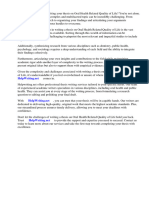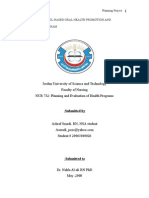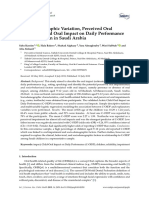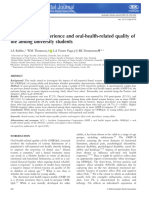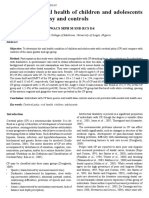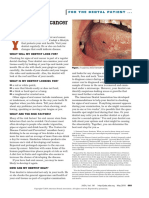Translation and Validation of The Arabic Version of The Geriatric Oral Health Assessment Index (GOHAI)
Translation and Validation of The Arabic Version of The Geriatric Oral Health Assessment Index (GOHAI)
Uploaded by
Taufiqurrahman Abdul DjabbarCopyright:
Available Formats
Translation and Validation of The Arabic Version of The Geriatric Oral Health Assessment Index (GOHAI)
Translation and Validation of The Arabic Version of The Geriatric Oral Health Assessment Index (GOHAI)
Uploaded by
Taufiqurrahman Abdul DjabbarOriginal Description:
Original Title
Copyright
Available Formats
Share this document
Did you find this document useful?
Is this content inappropriate?
Copyright:
Available Formats
Translation and Validation of The Arabic Version of The Geriatric Oral Health Assessment Index (GOHAI)
Translation and Validation of The Arabic Version of The Geriatric Oral Health Assessment Index (GOHAI)
Uploaded by
Taufiqurrahman Abdul DjabbarCopyright:
Available Formats
453
Journal of Oral Science, Vol. 50, No. 4, 453-459, 2008
Original
Translation and validation of the Arabic version of
the Geriatric Oral Health Assessment Index (GOHAI)
Shaher Daradkeh1) and Yousef S. Khader2)
1)Ministry
of Health, Irbid, Jordan
and Medical Sciences Sector, Higher Council for Science and Technology,
Department of Community Medicine, Public Health and Family Medicine, Faculty of Medicine,
Jordan University of Science and Technology, Irbid, Jordan
2)Health
(Received 16 June and accepted 22 October 2008)
Abstract: Our aim was to translate the original
English version of the Geriatric Oral Health Assessment
Index (GOHAI) into Arabic and assess its validity and
reliability for use among people in North Jordan. After
translation into Arabic and back-translation to check
the translation quality, a total of 288 participants
completed the Arabic version of the GOHAI
questionnaire. Individual GOHAI items were recoded
and summed as originally recommended. The
questionnaire sought information about sociodemographic characteristics and self-reported
perception of general and oral health. Clinical
examination included assessment of periodontal status,
and number of decayed teeth, missing teeth, filled teeth
and crowned teeth. Reliability, internal consistency,
and concurrent, convergent and discriminant validity
of GOHAI scores were examined. Mean GOHAI score
was 40.9 (SD = 10.6, range: 12 to 60). Cronbachs alpha
for the GOHAI score was 0.88, indicating a high degree
of internal consistency and homogeneity between the
GOHAI items. The test-retest correlation coefficient for
add-GOHAI scores was 0.72, indicating good stability.
Add-GOHAI scores increased with poorer perceived
general and oral health. Convergent validity, construct
validity and discriminant validity of the GOHAI were
demonstrated. The Arabic translation of the GOHAI
Correspondence to Dr. Yousef S. Khader, Health and Medical
Sciences Sector, Higher Council for Science and Technology,
Department of Community Medicine, Public Health and Family
Medicine, Faculty of Medicine, Jordan University of Science and
Technology, Irbid 22110, Jordan
Tel: +962-795435025
Fax: +962-2-7201064
E-mail: yousef.k@excite.com
demonstrated acceptable validity and reliability when
used for people in North Jordan. It could therefore be
used as a valuable instrument for measuring oral
health-related quality of life for people in this region.
(J. Oral Sci. 50, 453-459, 2008)
Keywords: validity; reliability; oral health; quality
of life; Arabic; Jordan.
Introduction
Measures of oral health-related quality of life (OHQoL)
are essential for epidemiological and clinical studies in order
to provide accurate data for health promotion, disease
prevention programs and allocation of health resources (1).
Other uses of such measures were described by Fitzpatrick
et al. (1) and Slade and Spencer (2). Most of the OHQoL
instruments (2-6) that have been shown to have adequate
validity and reliability are based on three main dimensions:
physical symptoms, perception of well-being and functional
capacity. Among the most commonly used instruments is
the Geriatric Oral Health Assessment Index (GOHAI)
(3). This has been validated and widely used in North
America. Its internal consistency is satisfactory and its
concurrent and construct validity have been confirmed
(7). Swedish (8), Malay (9), Chinese (10) and French (11)
versions have shown acceptable reliability and validity.
However, none of the indicators of OHQoL have been
validated in Arabic for use among people in North Jordan.
It is important that an adopted instrument should be
culturally relevant and valid for the local population while
demonstrating acceptable psychometric properties (1214). It is therefore essential to carry out a rigorous translation
and validation process of the instrument when used in
454
another population with a different culture. Therefore,
this study was conducted to translate the original English
version of the GOHAI into Arabic and validate it to
evaluate the impact of oral disease on the quality of life
of people in north Jordan
Methods
they were satisfied with their dental condition, their
assessment of their need for dental treatment, pain or
discomfort due to temporomandibular joint (TMJ)
disorders, burning mouth sensation, sensation of TMJ
clicking, and bad oral habits such as biting objects. Because
of the high illiteracy rate in North Badia, the questionnaire
was completed through personal interview.
Study population
A total of 300 consecutive people who had attended
North Badia Comprehensive Health Center for any reason
over a period of two months were invited to participate in
this study. After providing verbal consent to participate,
290 (96.7%) people were clinically examined. Two subjects
were excluded from the study because their questionnaire
answers were incomplete, leaving 288 to be included in
the analysis.
Translation and scoring of the GOHAI
The GOHAI was translated into Arabic by two dentists
who were fluent in both English and Arabic. The Arabic
draft was then back translated into English by another two
people fluent in both Arabic and English. The backtranslated version was compared with the original English
version to verify that the questions were properly translated.
All of the back-translated items were worded similarly to
the original ones and were comparable in their meaning.
The Arabic draft was then discussed by three dentists who
found that it would aid understanding to rephrase the
questions in the form of simple statements instead of
question format without changing their meaning. For
example, GOHAI item 1 How often do you limit the
kinds or amounts of food you eat because of problems with
your teeth or dentures? was restated as: Because of
problems with my teeth or dentures, I limit the kinds or
amounts of food I eat.
Individual GOHAI items were recoded and summed as
originally recommended. Two summary scores were
calculated. Add-GOHAI was calculated as the sum of
values of responses to the 12 items for each participant with
the resulting score ranging from 12-60. Simple count
score (SC-GOHAI) was calculated by counting the number
of GOHAI items with responses sometimes, often, or
always. Less than 5% of values were missing, and these
were replaced with the median of all values in the series.
Questionnaire
In addition to the 12 items of the GOHAI, the
questionnaire included socio-demographic characteristics
such as age, sex, educational level, marital status,
employment, and income. Subjects were also asked about
their perception of their general and oral health, whether
Clinical examination
The researchers assessed periodontal status and number
of decayed teeth, missing teeth, filled teeth, and crowned
teeth. Sterile dental mirrors and standardized periodontal
probes were used to measure probing pocket depth (PPD)
and clinical attachment level (CAL). PPD was measured
from the gingival margin to the bottom of the crevice to
the nearest millimeter (mm). If the cement-enamel junction
(CEJ) was exposed, CAL was measured by reading off the
distance from the CEJ or the margin of fixed restoration
to the base of the pocket. In other cases it was measured
indirectly by subtracting the distance from the gingival
margin to the CEJ from the pocket depth, with the tip of
the probe used to feel for the CEJ level. In both cases, CAL
was measured to the nearest mm.
PPD and CAL were measured at six sites (mesio-facial,
mid-facial, disto-facial, mesio-lingual, mid-lingual, and
disto-lingual) per tooth for all teeth, excluding third molars.
The number of decayed teeth, filled teeth, and missing teeth
for each participant were recorded. Periodontitis was
defined as presence of four or more teeth with PPD 4 mm
and CAL 3 mm at one site or more.
Reliability
Cronbachs alpha was calculated to assess the degree of
internal consistency and homogeneity between items (15).
Pearsons correlation coefficient was used to measure
item-scale correlation to assess the correlation between the
individual items and their scale score. To assess test-retest
reliability, 30 participants repeated the GOHAI one week
after the questionnaire was first administered. Test-retest
reliability was measured using Pearsons correlation
coefficient for individual items and for the overall GOHAI
score.
Validity
Concurrent validity was investigated by examining the
degree to which the GOHAI scores were related to the
scores of four self-reported items: general health, oral
health, need for dental care, and satisfaction with oral
health status. We assessed the ability of the GOHAI to
distinguish between groups of people with different
responses to these self-reported items, which it should
455
theoretically be able to do. Convergent validity was
evaluated by examining the association between GOHAI
scores and objective assessment of oral and dental status
(number of missing teeth, number of decayed teeth, and
the presence or absence of periodontal disease) and selfreported symptoms with hypothesized effects on oral
health-related quality of life: TMJ pain, burning mouth
sensation, and bad breath). It was predicted that subjects
who did not have one of such symptoms would have better
oral health-related quality of life and thus higher GOHAI
scores compared with subjects who had that symptom
(11,16). Discriminant validity was evaluated by examining
the association between GOHAI scores and self-reported
bad oral habits that were hypothesized not to be notably
associated with oral health-related quality of life (16) and
thus to have no effect on GOHAI scores.
Table 1 Socio-demographic and important characteristics of
participants
Statistical analysis
Statistical Package for Social Sciences (SPSS, version
11.5) software was used to analyze data. Frequency
distributions were produced. Means and standard deviations
of the dependent variables (Add-GOHAI and SC-GOHAI
scores) were estimated and compared among different
groups of the study population using a t-test or one-way
ANOVA as appropriate. Pearsons correlation coefficient
was used to measure item-scale correlations. Responses
to the 12-item questionnaire were subjected to factor
analysis using squared multiple correlations as prior
communality estimates. The principal components method
of factor extraction and varimax method of factor rotation
were used in factor analysis. A P-value of less than 0.05
was considered statistically significant.
Results
Participants characteristics
A total of 288 participants (155 men and 133 women)
agreed to participate and completed the GOHAI
questionnaire. Their socio-demographic characteristics
are shown in Table 1. Their mean age ( SD) was 33.4 (
13.2) years. A total of 134 (48.6%) respondents were 30
years of age or younger and 184 (63.9%) were married.
Monthly income was 160 JD or less (1 $ = 0.7 JD) for 106
(50.7%) respondents, and only 44 (15.3%) had attained
more than high school education. More than two thirds of
participants (70.7%) reported that they visited the dentist
only when they had pain and 118 (42.6%) reported that
they brushed their teeth once or more per day.
Self-perceived general and oral health
Table 2 shows the distribution of respondents according
to different self-reported ratings of health. Seventy-one
(24.8%) respondents reported that they had excellent
general health and 95 (33.2%) reported that they had very
good general health. Only 11.5% of the participants
reported that they had excellent oral health and 18.1%
perceived their oral health as being very good. Three
quarters of the subjects perceived themselves as needing
dental treatment. Only 36.9% of participants were satisfied
with their oral health status.
Oral health
Oral health examination showed that 65.6% of subjects
had at least one decayed tooth, 61.8% had at least one
missing tooth, 49.0% had one or more filled teeth, and
16.3% had one or more crowned teeth. Periodontal disease
was present in 33.3% of the subjects.
Acceptability of and responses to the Arabic
version of the GOHAI
The frequency of missing responses for GOHAI items
ranged from 0.1% to 3.8%.Using the add scoring method,
only one subject had a minimum score of 12, indicating
the greatest possible impact from oral conditions, and 9
456
Table 2 Distribution of participants according to self-reported
health-related ratings
(3.1%) subjects had the maximum score of 60 indicating
no impact. When the SC scoring method was used, 21
(7.3%) subjects had a score of zero and 11 (3.8%) subjects
had the maximum score of 12. The most common negative
impact (sometimes, often, or always) was sensitivity of teeth
or gums to hot, cold, or sweets.
Mean GOHAI score was 40.9 (SD = 10.6, range: 12 to
60). The mean number of negative impacts (sometimes,
often, or always) was 6.1 (SD = 3.5, range: 0 to12).
Factor analysis, reliability, and validity
Only one component was extracted. The factor loadings
ranged from 0.51 to 0.78 for all items except for item 5.
Cronbachs alpha for the GOHAI was 0.88, indicating a
high degree of internal consistency and homogeneity
between the GOHAI items. The item-scale correlation
coefficients ranged from 0.53 to 0.77 for all items except
item 5, which had a correlation coefficient of 0.27. The
mean values of the individual GOHAI items were close
to each other. Test-retest correlation coefficients ranged
from 0.41 to 0.75 for all individual items except item 5,
which had a test-retest coefficient of 0.01. The test-retest
correlation for the total add-GOHAI score was 0.72
indicating good stability.
Concurrent validity for the GOHAI was evaluated by
examining the correlation between self-perceived general
and oral health status and the two GOHAI summary scores
(Table 3). Add-GOHAI scores increased with poorer
perceived general and oral health. As self-reported general
and oral health decreased, SC score (number of negative
impacts) increased, indicating poorer health and oral
health-related quality of life. Furthermore, people who
perceived themselves as needing dental care or those who
were not satisfied with their oral health status had a
significantly lower mean GOHAI and higher mean SCGOHAI scores, indicating poorer oral health-related quality
of life.
As predicted, lower add-GOHAI scores were associated
with self-reported TMJ pain, burning mouth sensation, and
bad breath, a finding that supports convergent validity
(Table 4). Participants who had one or more missing or
decayed teeth had lower add-GOHAI scores than those who
had no missing or decayed teeth. Those with periodontal
disease had lower add-GOHAI scores than those without
periodontal disease (P < 0.005), supporting construct
validity of the add-GOHAI.
Discriminant validity was evaluated by examining the
association between GOHAI scores and self-reported bad
oral habits which were hypothesized not to be notably
associated with oral health-related quality of life and thus
have no effect on the GOHAI scores. Table 5 shows that
there was no statistically significant difference in GOHAI
scores between those who reported bad oral habits and those
who did not. Moreover, GOHAI could not discriminate
between participants according to the number of filled or
crowned teeth.
GOHAI scores were also studied among groups known
to have different levels of health. Results were as expected.
Respondents who were older than 30 and those with a low
level of education had lower add-GOHAI and higher SCGOHAI scores. GOHAI discriminated between the subjects
according to tooth brushing; those who regularly brushed
their teeth had higher add-GOHAI scores than others
(Table 6).
457
Table 3 Concurrent validity: Correlation between self-reported general and
oral health and the Geriatric Oral Health Assessment Index (GOHAI)
scores
Table 4 Convergent validity: Differences in the average of the Geriatric Oral Health
Assessment Index (GOHAI) scores (Add-GOHAI and SC-GOHAI) according to
self-reported responses to different health-related questions and objective assessment
of oral health
Table 5 Discriminant validity: Differences in the average of the Geriatric Oral
Health Assessment Index (GOHAI) scores (Add-GOHAI and SC-GOHAI)
according to variables that have no predicted effect on oral health related
quality of life
458
Table 6 Association between variables with predicted effect on oral health-related quality
of life and the GOHAI score
Discussion
This study examined the validity and reliability of the
GOHAI Arabic version in a selected group of people in
north Jordan. The GOHAI, which was originally developed
and tested in well-educated, elderly Americans (3) has also
been demonstrated suitable in younger, poorly educated
populations.
When used among Jordanian people, the Arabic version
of the GOHAI showed acceptable validity and reliability.
However, it was noticeable that the proportion of subjects
reporting discomfort when eating anything (Q5) was lower
than that reporting other problems. This item was also
atypical in other ways. It had a low item-scale correlation
and was poorly correlated with other items. The most
likely explanation is that this item was one of three items
worded in a positive direction while the remaining items
were worded in a negative direction, which might have
caused a misunderstanding. The three positively worded
items had the lowest item-scale correlations.
Factor analysis extracted only one component. Factor
loadings ranged from 0.51 to 0.78 for all items except for
item 5, suggesting that the Arabic version of GOHAI
demonstrated good internal consistency. Cronbachs alpha
coefficient (0.88) was comparable to that obtained from
the French version (0.86) (12) and higher than those for
versions of the GOHAI in other languages, which varied
from 0.74 to 0.81 (3,8-10,17). Item-scale correlations
varied from 0.27 to 0.77 in the Arabic version, compared
with 0.28 to 0.61 in the Chinese version (10) and 0.40 to
0.78 in the French version (11).
When 30 subjects retook the questionnaire one week after
it was first administered, the test-retest correlation
coefficient between the add-GOHAI scores was 0.72. This
finding was similar to that reported for the Malay version
(0.72) (9) and lower than that reported for the French
version (0.87) (11).
Self-rating of oral health was poor and perception of need
for dental treatment was very high, indicating a substantial
negative impact of oral conditions among this population.
The low socio-economic status of this population may
explain the relatively large negative impact of oral
conditions on functioning and well-being.
Concurrent validity of the Arabic GOHAI version was
comparable to that of the original English GOHAI version
(3). The analysis demonstrated the expected associations
between the GOHAI score and the reported oral and
general health status, perceived need for dental treatment,
and self satisfaction with oral health. Lower add-GOHAI
scores were associated with poorer perceived oral and
general health, need for dental care, and low satisfaction
with oral health.
Regarding convergent validity, this study supported
others (2) in showing that people with TMJ pain, burning
mouth sensation, or self reported bad breath had lower addGOHAI scores than those who did not have these
symptoms. Bad oral habits did not have any significant
effect on the GOHAI score. However, education and
employment were important factors influencing the GOHAI
score, as reported previously (7,17).
This study found significant relationships between the
GOHAI and certain clinical measures including number
of missing teeth, number of decayed teeth, and periodontal
status. However, associations between the GOHAI score
and the number of filled or crowned teeth were not
significant. Missing and decayed teeth affect eating,
esthetics, and speech, and dental decay may cause pain and
discomfort. Periodontal diseases cause tooth mobility,
tooth loss, limiting the ability to eat comfortably and
resulting in esthetic and speech problems. On the other
hand, fillings and crowns are designed to restore as much
of the lost function and esthetics as possible, accounting
for the fact that those with filled and crowned teeth did
459
not score significantly worse on the GOHAI than others.
In conclusion, the Arabic translation of the GOHAI
demonstrated acceptable validity and reliability when used
for people in north Jordan. It could therefore be a valuable
instrument for measuring oral health-related quality of
life for people in this region. Further research is needed
to examine the stability of the GOHAI over different
periods of time and to examine it as a tool to evaluate dental
treatment outcomes in the Jordanian population.
References
1. Fitzpatrick R, Fletcher A, Gore S, Jones D,
Spiegelhalter D, Cox D (1992) Quality of life
measures in health care. I: Applications and issues
in assessment. BMJ 305, 1074-1077
2. Slade GD, Spencer AJ (1994) Development and
evaluation of the Oral Health Impact Profile.
Community Dent Health 11, 3-11
3. Atchison KA, Dolan TA (1990) Development of the
Geriatric Oral Health Assessment Index. J Dent
Educ 54, 680-687
4. Strauss RP, Hunt RJ (1993) Understanding the value
of teeth to older adults: influences on the quality of
life. J Am Dent Assoc 124, 105-110
5. McGrath C, Bedi R (2003) Measuring the impact
of oral health on quality of life in Britain using
OHQoL-UK(W). J Public Health Dent 63, 73-77
6. Leao A, Sheiham A (1996) The development of a
socio-dental measure of dental impacts on daily
living. Community Dent Health 13, 22-26
7. Atchison KA (1997). The General Oral Health
Assessment Index. In Measuring Oral Health and
Quality of Life, Slade GD ed, Chapel Hill, 79-80
8. Hgglin C, Berggren U, Lundgren J (2005) A
Swedish version of the GOHAI index. Psychometric
properties and validation. Swed Dent J 29, 113124
9. Othman WN, Muttalib KA, Bakri R, Doss JG, Jaafar
N, Salleh NC, Chen S (2006) Validation of the
Geriatric Oral Health Assessment Index (GOHAI)
in the Malay language. J Public Health Dent 66, 199204
10. Wong MC, Liu JK, Lo EC (2002) Translation and
validation of the Chinese version of GOHAI. J
Public Health Dent 62, 78-83
11. Tubert-Jeannin S, Riordan PJ, Morel-Papernot A,
Porcheray S, Saby-Collet S (2003) Validation of an
oral health quality of life index (GOHAI) in France.
Community Dent Oral Epidemiol 31, 275-284
12. Guillemin F, Bombardier C, Beaton D (1993) Crosscultural adaptation of health-related quality of life
measures: literature review and proposed guidelines.
J Clin Epidemiol 46, 1417-1432
13. Allison P, Locker D, Jokovic A, Slade G (1999) A
cross-cultural study of oral health values. J Dent Res
78, 643-649
14. Corless IB, Nicholas PK, Nokes KM (2001) Issues
in cross-cultural quality-of-life research. J Nurs
Scholarsh 33, 15-20
15. Cronbach LJ (1951) Coefficient alpha and the
internal structure of tests. Psychometrika 16, 297334
16. John MT, Patrick DL, Slade GD (2002) The German
version of the Oral Health Impact Profile/translation
and psychometric properties. Eur J Oral Sci 110, 425433
17. Allen PF (2003) Assessment of oral health related
quality of life. Health Qual Life Outcomes 1, 40
You might also like
- Mathur Et Al 2016 GerodontologyDocument8 pagesMathur Et Al 2016 GerodontologyBrijesh MaskeyNo ratings yet
- 06 Navin IngleDocument12 pages06 Navin IngleFaradhillah KartonoNo ratings yet
- Validation of An Oral Health Quality of Life Index (GOHAI) in FranceDocument10 pagesValidation of An Oral Health Quality of Life Index (GOHAI) in Franceimad.elmennany-etuNo ratings yet
- Gradientes Sociales en El Estado de Salud Bucal en La Población de CoreaDocument6 pagesGradientes Sociales en El Estado de Salud Bucal en La Población de CoreaStefania Vargas PerezNo ratings yet
- Impact of Orthodontic Treatment On Oral Health-Related Quality of Life in The Slovak Republic: A Cross-Sectional StudyDocument10 pagesImpact of Orthodontic Treatment On Oral Health-Related Quality of Life in The Slovak Republic: A Cross-Sectional StudyKornist BufuNo ratings yet
- UNMET ORAL HEALTH NEEDS ArticleDocument5 pagesUNMET ORAL HEALTH NEEDS ArticleKhalil PakistanNo ratings yet
- Uoi 142 FDocument9 pagesUoi 142 FbkprosthoNo ratings yet
- Proposal FinalDocument6 pagesProposal FinalYussuf OmarNo ratings yet
- Thesis On Oral Health Related Quality of LifeDocument5 pagesThesis On Oral Health Related Quality of Lifeafknawjof100% (2)
- SudanDocument5 pagesSudanNaji Z. ArandiNo ratings yet
- Scientific Articles: 1. Dalius Petrauskas, Janina Petkeviciene, Jurate Klumbiene, Jolanta SiudikieneDocument8 pagesScientific Articles: 1. Dalius Petrauskas, Janina Petkeviciene, Jurate Klumbiene, Jolanta SiudikieneChandra Sekhar ThatimatlaNo ratings yet
- Health Behaviors, Tooth Number, and Oral Health-Related Quality of Life Among Thai Older AdultsDocument6 pagesHealth Behaviors, Tooth Number, and Oral Health-Related Quality of Life Among Thai Older Adultsmommi fkgNo ratings yet
- Electronic Physician (ISSN: 2008-5842)Document5 pagesElectronic Physician (ISSN: 2008-5842)Dennis MejiaNo ratings yet
- JordanDocument6 pagesJordanNaji Z. ArandiNo ratings yet
- School-Based Oral Health Promotion and Prevention ProgramDocument30 pagesSchool-Based Oral Health Promotion and Prevention ProgramAshraf Ali Smadi100% (6)
- Oral Health LiteracyDocument7 pagesOral Health Literacyhairun hairunNo ratings yet
- Effect of Socioeconomic Status On Normative and Perceived Orthodontic Treatment NeedDocument6 pagesEffect of Socioeconomic Status On Normative and Perceived Orthodontic Treatment NeedshafiraNo ratings yet
- 305-Article Text-526-1-10-20181121Document5 pages305-Article Text-526-1-10-20181121Sakina FatimaNo ratings yet
- Caries in DisabledDocument7 pagesCaries in DisabledSOMVIR KUMARNo ratings yet
- Oral HygieneDocument9 pagesOral HygieneemeraldwxyzNo ratings yet
- BrazJOralSci 2013 Vol12 Issue1 p5 10Document6 pagesBrazJOralSci 2013 Vol12 Issue1 p5 10Taufiqurrahman Abdul DjabbarNo ratings yet
- Association Between Caries and Oral Health Habits in Male Saudi Adolescents LASTDocument7 pagesAssociation Between Caries and Oral Health Habits in Male Saudi Adolescents LASTrajtanniruNo ratings yet
- Socio-Demographic Variation, Perceived Oral Impairment and Oral Impact On Daily Performance Among Children in Saudi ArabiaDocument9 pagesSocio-Demographic Variation, Perceived Oral Impairment and Oral Impact On Daily Performance Among Children in Saudi ArabiaRizka FitrissaNo ratings yet
- Original Article Oral Dryness Among Japanese Youth: Development of A Japanese Questionnaire On Oral Dryness and The Impact of Daily Life On ItDocument6 pagesOriginal Article Oral Dryness Among Japanese Youth: Development of A Japanese Questionnaire On Oral Dryness and The Impact of Daily Life On ItDanis Diba Sabatillah YaminNo ratings yet
- Oral Health - JKCD 2019Document6 pagesOral Health - JKCD 2019Jawad TariqNo ratings yet
- Article Numgggber 2Document6 pagesArticle Numgggber 2Hub SciNo ratings yet
- Translation and Psychometric Properties of The Swedish Version of The Index of Dental Anxiety and Fear (IDAF-4C)Document7 pagesTranslation and Psychometric Properties of The Swedish Version of The Index of Dental Anxiety and Fear (IDAF-4C)baridinoNo ratings yet
- CDH 4550barasuol05Document5 pagesCDH 4550barasuol05Deepakrajkc DeepuNo ratings yet
- Jced 11 E1143Document8 pagesJced 11 E1143rugeaelzwea2No ratings yet
- Self-Perception of Periodontal Health and Associated Factors: A Cross-Sectional Population-Based StudyDocument14 pagesSelf-Perception of Periodontal Health and Associated Factors: A Cross-Sectional Population-Based StudyatikramadhaniNo ratings yet
- Adj 12774Document5 pagesAdj 12774Irfan HussainNo ratings yet
- 2 Oral Care in All YearsDocument10 pages2 Oral Care in All Yearsneetika guptaNo ratings yet
- Quality of Life and Psychosocial Outcomes After Fixed Orthodontic TreatmentDocument11 pagesQuality of Life and Psychosocial Outcomes After Fixed Orthodontic TreatmentAhmad Ulil AlbabNo ratings yet
- Hu Dbi IndiaDocument6 pagesHu Dbi IndiaSilvia Daniela CojocariuNo ratings yet
- Medoralv16 I6 p745 PDFDocument5 pagesMedoralv16 I6 p745 PDFAyu Ervita HydayatyNo ratings yet
- 2.jpmh 2023 01 E78Document9 pages2.jpmh 2023 01 E78mehulshah1126No ratings yet
- Oral Hygiene and Number of Oral Mucosal Lesion Correlate With Oral Health-Related Quality of Life in Elderly CommunitiesDocument5 pagesOral Hygiene and Number of Oral Mucosal Lesion Correlate With Oral Health-Related Quality of Life in Elderly CommunitiesRida EANo ratings yet
- Dental Caries Experience and Oral Health Related Quality of Life in Working AdultsDocument8 pagesDental Caries Experience and Oral Health Related Quality of Life in Working AdultsArida BitanajshaNo ratings yet
- Knowledge, Attitudes, Practices and Status of Oral Health Among Diabetic Patients at Kikuyu HospitalDocument2 pagesKnowledge, Attitudes, Practices and Status of Oral Health Among Diabetic Patients at Kikuyu HospitalNthie UnguNo ratings yet
- Perception Halitosis of Students in Al Jouf UniversityDocument5 pagesPerception Halitosis of Students in Al Jouf UniversityChit Tat Thu LayNo ratings yet
- Archive of SIDDocument6 pagesArchive of SIDBeuty SavitriNo ratings yet
- Ohs. AlkharjDocument7 pagesOhs. AlkharjLayal J. AlQahtaniNo ratings yet
- Study Regarding The Correlation Between The Child-OIDP Index and The Dental Status in 12-Year-Old Children From Harsova, Constanta CountyDocument10 pagesStudy Regarding The Correlation Between The Child-OIDP Index and The Dental Status in 12-Year-Old Children From Harsova, Constanta Countydup11No ratings yet
- Ecde 18 01269Document11 pagesEcde 18 01269haneenhayazaaNo ratings yet
- Oral Health-Related Quality of Life of Children and Adolescents With and Without Migration Background in GermanyDocument9 pagesOral Health-Related Quality of Life of Children and Adolescents With and Without Migration Background in Germanylourdes marquezNo ratings yet
- Comparative Oral Health of Children and Adolescents With Cerebral Palsy and ControlsDocument7 pagesComparative Oral Health of Children and Adolescents With Cerebral Palsy and ControlsVinzNo ratings yet
- Kragt 2017Document7 pagesKragt 2017zhrieeNo ratings yet
- Froh 02 732882Document8 pagesFroh 02 732882ronaaqilahusnaNo ratings yet
- Derivation and Validation of A Short-Form Oral Health Impact ProfileDocument8 pagesDerivation and Validation of A Short-Form Oral Health Impact Profilewowzers1000No ratings yet
- tmp1F38 TMPDocument6 pagestmp1F38 TMPFrontiersNo ratings yet
- Jenny Abanto, Georgios Tsakos, Saul Martins Paiva, Thiago S. Carvalho, Daniela P. Raggio and Marcelo BöneckerDocument10 pagesJenny Abanto, Georgios Tsakos, Saul Martins Paiva, Thiago S. Carvalho, Daniela P. Raggio and Marcelo BöneckerTasya AwaliyahNo ratings yet
- International Journal of Health Sciences and ResearchDocument7 pagesInternational Journal of Health Sciences and ResearchNabila RizkikaNo ratings yet
- Prpposal Presentation Oct 2011 RevDocument34 pagesPrpposal Presentation Oct 2011 RevLeilawati SulaimanNo ratings yet
- Acharya 2009Document6 pagesAcharya 2009miltonlafebreNo ratings yet
- Effect of Tongue Brushing On Oral Malodor in AdolescentsDocument5 pagesEffect of Tongue Brushing On Oral Malodor in AdolescentsMarian Si Teofana HasnaNo ratings yet
- Le N Et Al 2016 GerodontologyDocument9 pagesLe N Et Al 2016 GerodontologyBrijesh MaskeyNo ratings yet
- 4 ARTIGO SECCIONAL Piuvezam & Lima 2012 Archives of GeriatricsDocument8 pages4 ARTIGO SECCIONAL Piuvezam & Lima 2012 Archives of Geriatricsraissa.pereira.106No ratings yet
- Oral Health Related Quality of Life ThesisDocument5 pagesOral Health Related Quality of Life Thesisb0sus1hyjaf2100% (2)
- Caac172 PDFDocument4 pagesCaac172 PDFTaufiqurrahman Abdul DjabbarNo ratings yet
- Dental Patient 0510 PDFDocument1 pageDental Patient 0510 PDFTaufiqurrahman Abdul DjabbarNo ratings yet
- Management of C Shaped Canals: 3 Case ReportsDocument3 pagesManagement of C Shaped Canals: 3 Case ReportsTaufiqurrahman Abdul Djabbar100% (1)
- Living Oracles of The Law and The Fallacy of Human Divination PDFDocument14 pagesLiving Oracles of The Law and The Fallacy of Human Divination PDFTaufiqurrahman Abdul DjabbarNo ratings yet
- Relationship Between Gender, Income and Education and Self-Perceived Oral Health Among Elderly Mexicans. An Exploratory StudyDocument8 pagesRelationship Between Gender, Income and Education and Self-Perceived Oral Health Among Elderly Mexicans. An Exploratory StudyTaufiqurrahman Abdul DjabbarNo ratings yet
- BrazJOralSci 2013 Vol12 Issue1 p5 10Document6 pagesBrazJOralSci 2013 Vol12 Issue1 p5 10Taufiqurrahman Abdul DjabbarNo ratings yet
- GOHAIDocument8 pagesGOHAITaufiqurrahman Abdul DjabbarNo ratings yet
- OMS Resident ManualDocument84 pagesOMS Resident ManualTaufiqurrahman Abdul DjabbarNo ratings yet
- Final Article Drugs and AgingDocument11 pagesFinal Article Drugs and AgingTaufiqurrahman Abdul DjabbarNo ratings yet
- Vol09 2 3-5str PDFDocument3 pagesVol09 2 3-5str PDFTaufiqurrahman Abdul DjabbarNo ratings yet
- Open Positions ExternshipDocument22 pagesOpen Positions ExternshipTaufiqurrahman Abdul DjabbarNo ratings yet
- Inflammation and RegenerationDocument6 pagesInflammation and RegenerationTaufiqurrahman Abdul DjabbarNo ratings yet
- Journal of Endodontics January 2016 420Document2 pagesJournal of Endodontics January 2016 420Taufiqurrahman Abdul DjabbarNo ratings yet
- Jcpe 12081Document14 pagesJcpe 12081Taufiqurrahman Abdul DjabbarNo ratings yet
- Arteriovenous Malformation of The Oral Cavity A Case Report 2332 0702 1000174Document4 pagesArteriovenous Malformation of The Oral Cavity A Case Report 2332 0702 1000174Taufiqurrahman Abdul DjabbarNo ratings yet
- Protecting All Children's Teeth: Oral InjuryDocument50 pagesProtecting All Children's Teeth: Oral InjuryTaufiqurrahman Abdul DjabbarNo ratings yet
- Determination of Mutagenicity of The Precipitate Formed by Sodium Hypochlorite and Chlorhexidine Using The Ames TestDocument6 pagesDetermination of Mutagenicity of The Precipitate Formed by Sodium Hypochlorite and Chlorhexidine Using The Ames TestTaufiqurrahman Abdul DjabbarNo ratings yet
- Buccal Mucosa Cancer Final PDF 9.6.14 PDFDocument36 pagesBuccal Mucosa Cancer Final PDF 9.6.14 PDFTaufiqurrahman Abdul DjabbarNo ratings yet
- OC Guideline 2008Document8 pagesOC Guideline 2008Taufiqurrahman Abdul DjabbarNo ratings yet
- WC BPR - Prevention and Management of Wounds 1515r4e FinalDocument74 pagesWC BPR - Prevention and Management of Wounds 1515r4e FinalFransiscus Braveno RapaNo ratings yet
- Public Health Exam Questions 2019-20Document75 pagesPublic Health Exam Questions 2019-20annie svobodovaNo ratings yet
- Andrade 2020Document5 pagesAndrade 2020Laura GarciaNo ratings yet
- EORTC QLQ-C30 Into Indonesian VersionDocument11 pagesEORTC QLQ-C30 Into Indonesian VersionHendryNo ratings yet
- Researcher Square Paper PDFDocument30 pagesResearcher Square Paper PDFMaryoma HabibyNo ratings yet
- 2024 American Society of Clinical Oncology Genitourinary (ASCO-GU) Cancers SymposiumDocument8 pages2024 American Society of Clinical Oncology Genitourinary (ASCO-GU) Cancers SymposiumJad DegheiliNo ratings yet
- Urn - Isbn - 978 952 61 2713 2Document136 pagesUrn - Isbn - 978 952 61 2713 2dewi najiraNo ratings yet
- THE Quality OF Life AND Caregiving Burden Among Caregivers OF People With Dementia IN Hanoi, BAC Ninh AND HAI Phong, VietnamDocument310 pagesTHE Quality OF Life AND Caregiving Burden Among Caregivers OF People With Dementia IN Hanoi, BAC Ninh AND HAI Phong, VietnamCHEE KOK SENGNo ratings yet
- Quality of Life in Patients Suffering From InsomniaDocument14 pagesQuality of Life in Patients Suffering From InsomniaAkhmad VauwazNo ratings yet
- Daily Prednisone Treatment in Duchenne Muscular Dystrophy in Southwest ChinaDocument7 pagesDaily Prednisone Treatment in Duchenne Muscular Dystrophy in Southwest ChinaEduardoNo ratings yet
- Laser Epilation As An Adjunct To Standard Care in Reducing Pilonidal Disease Recurrence in Adolescents and Young AdultsDocument9 pagesLaser Epilation As An Adjunct To Standard Care in Reducing Pilonidal Disease Recurrence in Adolescents and Young Adultsbicetre2019No ratings yet
- Patient Reported Outcomes in Clinical Trials From An 2023 Seminars in RadiDocument9 pagesPatient Reported Outcomes in Clinical Trials From An 2023 Seminars in RadiFlavio GuimaraesNo ratings yet
- Quality of Life in Systemic SclerosisDocument10 pagesQuality of Life in Systemic SclerosisIsa RahmatikawatiNo ratings yet
- The Psycho-Social Impact of Malocclusions and Trea PDFDocument10 pagesThe Psycho-Social Impact of Malocclusions and Trea PDFClaypella MaskNo ratings yet
- Assessment of Oral Health-Related Quality of Life Among Head-And-Neck Cancer Patients Attending Cancer Care Center at Kanchipuram, Tamil Nadu  A Cross-Sectional StudyDocument7 pagesAssessment of Oral Health-Related Quality of Life Among Head-And-Neck Cancer Patients Attending Cancer Care Center at Kanchipuram, Tamil Nadu  A Cross-Sectional StudyFelix SchweppeNo ratings yet
- Dass Translation and Validation Procedure in The Greek LanguageDocument15 pagesDass Translation and Validation Procedure in The Greek LanguageAchilleana KonstantiNo ratings yet
- Development of A Scale To Measure Health-Related Quality of Life of Cancer PatientsDocument7 pagesDevelopment of A Scale To Measure Health-Related Quality of Life of Cancer PatientsInternational Journal of Arts, Humanities and Social Studies (IJAHSS)No ratings yet
- Palliative Care For Stroke Patients and Their Families: Barriers For ImplementationDocument8 pagesPalliative Care For Stroke Patients and Their Families: Barriers For ImplementationMaisury LadjidjiNo ratings yet
- Neurorehabilitation in Neuro-Oncology 2019 E-BookDocument254 pagesNeurorehabilitation in Neuro-Oncology 2019 E-BookWoffe SoloNo ratings yet
- Activity Centre For Elderly in BhubaneswarDocument15 pagesActivity Centre For Elderly in BhubaneswarBradley MitchellNo ratings yet
- Addendum To The EORTC QLQ-C30 Scoring Manual: Scoring of The EORTC QLQ-C15-PALDocument10 pagesAddendum To The EORTC QLQ-C30 Scoring Manual: Scoring of The EORTC QLQ-C15-PALGuadalupe Coromoto Perez LezamaNo ratings yet
- Pharmacoeconomics LceDocument118 pagesPharmacoeconomics LceHope GemidaNo ratings yet
- Azmi, Et Al. (2015) Quality of Life Among Patients With Acute Coronary Syndrome in MalaysiaDocument4 pagesAzmi, Et Al. (2015) Quality of Life Among Patients With Acute Coronary Syndrome in Malaysiacipto susiloNo ratings yet
- Olalekan Et Al. 2019Document12 pagesOlalekan Et Al. 2019karamabbaskeremNo ratings yet
- s12955 023 02123 ZDocument11 pagess12955 023 02123 ZLeiNo ratings yet
- Data Pneumonia 2Document5 pagesData Pneumonia 2Dini BerlianaNo ratings yet
- Translation and Validation of The Arabic Version of The Geriatric Oral Health Assessment Index (GOHAI)Document7 pagesTranslation and Validation of The Arabic Version of The Geriatric Oral Health Assessment Index (GOHAI)Taufiqurrahman Abdul DjabbarNo ratings yet
- Iranian Re v19n3p315 enDocument10 pagesIranian Re v19n3p315 enEmeraldamrNo ratings yet
- Jurnal Sistem Imun PDFDocument15 pagesJurnal Sistem Imun PDFYenni Sinaga100% (4)
- Musculoskeletal Complaints, Physical Activity and Health-Related Quality of Life Among Patients With The Ehlers-Danlos Syndrome Hypermobility Type, Disability and Rehabilitation, Informa HealthcareDocument1 pageMusculoskeletal Complaints, Physical Activity and Health-Related Quality of Life Among Patients With The Ehlers-Danlos Syndrome Hypermobility Type, Disability and Rehabilitation, Informa HealthcareWasemBhatNo ratings yet








